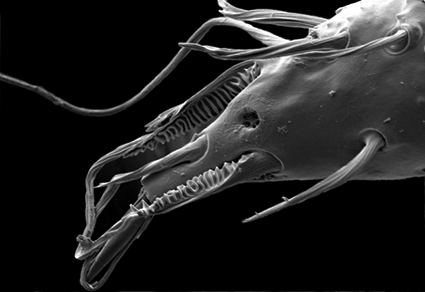Abstract
We describe three new genera and four new species of small, litter-dwelling millipedes from the states of Oregon and Washington, USA: Miniaria ramifera, n. gen., n. sp., Miniaria richarti, n. gen., n. sp., Tigraria oregonensis, n. gen., n. sp., and Kingaria prattensis, n. gen., n. sp. Some of the unusual characters of these species are discussed, including a new type of sensory array on the third tarsus of males and a newly observed mandibular gland.
References
- Bollman, C.H. (1893) The Myriapoda of the United States. United States National Museum Bulletin, 43, 1–210.
- Chamberlin, R.V. (1941) New western millipedes. Bulletin of the University of Utah, Biological Series 6, 31 (2), 3–23.
- Cook, O.F. (1896) On recent diplopod names. Brandtia, 2, 5–8.
- Hoffman, R.L. (1999) Checklist of the millipeds of North and Middle America. Virginia Museum of Natural History Special Publication, 8, 1–584.
- Shear, W.A. (2020) The millipede family Striariidae Bollman, 1893. I. Introduction to the family, synonymy of Vaferaria Causey with Amplaria Chamberlin, the new subfamily Trisariinae, the new genus Trisaria, and three new species (Diplopoda, Chordeumatida, Striarioidea). Zootaxa, 4758 (2), 275–295. https://doi.org/10.11646/zootaxa.3109.1.1
- Shear, W.A. (2021a) The millipede family Striariidae Bollman, 1893. II. New records and species of the genus Amplaria Chamberlin, 1941 (Diplopoda, Chordeumatida, Striarioidea). Zootaxa, 4908 (2), 205–224. https://doi.org/10.11646/zootaxa.4908.2.3
- Shear, W.A. (2021b) The millipede family Striariidae Bollman, 1893. III. Four new species of Striaria Bollman, 1888 (Diplopoda, Chordeumatida, Striarioidea). Zootaxa, 4920 (3), 395–406. https://doi.org/10.11646/zootaxa.4920.3.5
- Shear, W.A. & Marek, P.E. (2022a) The millipede family Striariidae Bollman, 1893. V. Stegostriaria dulcidormus, n. gen., n. sp., Kentrostriaria ohara, n. gen., n. sp., and the convergent evolution of exaggerated metazonital crests (Diplopoda, Chordeumatida, Striarioidea). Zootaxa, 5094 (3), 461–472. https://doi.org/10.11646/zootaxa.5094.3.5
- Shear, W.A. & Marek, P.E. (2022b) The millipede family Striariidae Bollman, 1893. VI. Six new genera and thirteen new species from western North America (Diplopoda, Chordeumatida, Striarioidea). Zootaxa, 5205 (6), 501–531. https://doi.org/10.11646/zootaxa.5205.6.1
- Shear, W.A., Nosler, P. & Marek, P.E. (2022a) The millipede family Striariidae Bollman, 1893. IV. Amplaria oedipus, n. sp., with a secondary sexual modification of males unique among millipedes (Diplopoda, Chordeumatida, Striarioidea. Zootaxa, 5099 (1), 137–145. https://doi.org/10.11646/zootaxa.5099.1.7
- Shear, W.A., Marek, P.E., Bond, J.E. & Wesener, T. (2022b) The millipede family Striariidae Bollman, 1893. VII. Petra sierwaldae, n. gen., n. sp., a minute millipede from Idaho, USA (Diplopoda, Chordeumatida, Striarioidea). Zootasa, 5213 (3), 287–293. https://doi.org/10.1111/j.1469-7998.2011.00892.x
- Wojciezek, J.M., Austin, P., Harvey, M.S. & Simmons, L.W. (2012) Micro-DT scanning provides insight into the functional morphology of millipede genitalia. Journal of Zoology, 287, 91–96.


